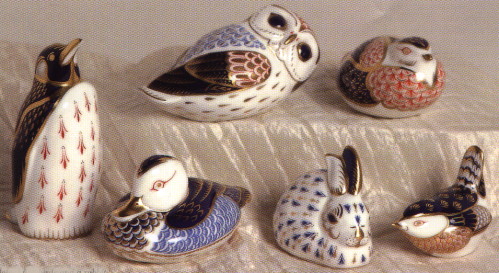| A Brief History
Royal Crown Derby introduced the first six paperweights in September 1981 at Chatsworth House, Derbyshire. These paperweights were the Duck, Owl, Penguin, Quail, Rabbit and Wren. |
|
|
|
Paperweights had traditionally been manufactured from materials like glass as they could withstand the odd knock. Rarely had ceramics been used, possibly because it was considered too fragile. Despite this potential problem, Jo Ledger, Art Director of Royal Doulton (of which Royal Crown Derby formed part), conceived the idea of a range of ceramic paperweights that would be unique to Royal Crown Derby. The character of these paperweights would appeal to customers as aesthetically attractive ornaments whilst being a functional item too. Having decided to create a range of paperweights, the next problem was the form they should take. After researching historical and contemporary wares, it was decided that sculptures of birds and animals would have greatest appeal. This decision also took into account the strong tradition of manufacturing ceramic figures at the Derby factories dating back to the early days of the Nottingham Road factory around 1750. The range would be in a style that appealed to contemporary tastes whilst the decoration would continue the Derby traditions of rich decoration. It was felt important to incorporate the 'Imari' patterns which were developed in the Derby factories from the late 18th century due to the popularity in Europe of the Japanese porcelain wares decorated in underglaze blue with overglaze iron red and gilding. These wares were exported to the West via the port of Imari in Japan's Arita province. The value placed on the importance of tradition in the paperweights can clearly be seen from the publicity brochure that accompanied the 1981 launch: "These charming paperweights were modelled by internationally renowned sculptor Robert Jefferson and decorated by June and Brian Branscombe in a style so quintessentially Royal Crown Derby. Blue, red and gold are used in new pattern forms which draw their inspiration from Derby's long tradition of 'Imari' decorations. Robert Jefferson, a freelance sculptor who had previously worked for the Poole Pottery Studio in Dorset, first became involved with Jo Ledger when commissioned to produce a couple of animal sculptures for developing the idea of a new range at Tutbury Crystal (also part of the Royal Doulton group). Unfortunately they were unsuitable for translation into glass so sat on a shelf in the design studio gathering dust until Jo retrieved them for consideration for the new paperweight range. Robert Jefferson was the asked to come up with some ideas for the range and prototype clay models were made for the introductory paperweights. When it had been agreed that the design brief for the models had been met, they were put into trial production and bone china bodies were made. At this stage Jo Ledger asked Brian Branscombe, Art Director at Derby, and his wife June, who was also a designer at the Derby Art Studio, to design the decoration for the paperweights. Using the traditional 'Imari' colour palette - Mazarine Blue, Iron Red and Gold - June and Brian met the design brief for the decoration. The final stage was to translate the designs into workable production stages using the skills which June and Brian had developed with Avis Garton and her twin sister May. Little did anyone guess that the paperweight range would not only be extremely successful but would also help to transform the overall prospects of Royal Crown Derby in the 1990's.
|
|
|
|
Visitors since December 2002 |
